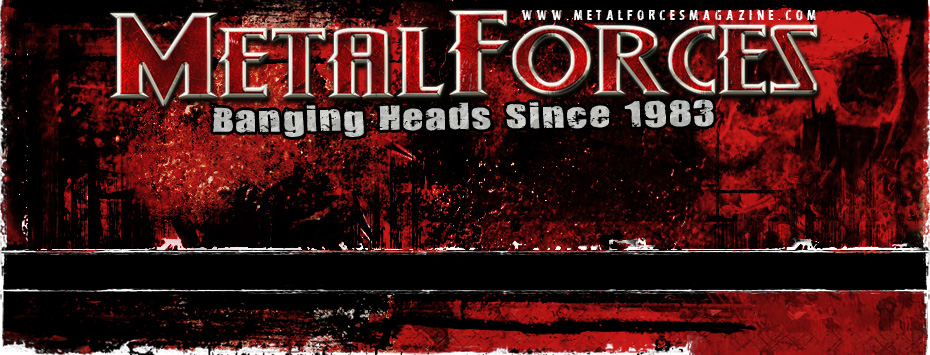
SINSAENUM – Monarchs Of Death And Black
Anthony Morgan
November 2017
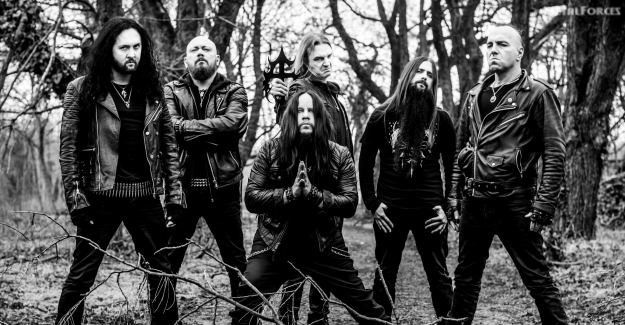 Sinsaenum (l-r): Frédéric Leclercq, Stéphane Buriez, Joey Jordison (front), Heimoth (back), Sean Zatorsky and Attila Csihar |
![]()
Extreme death / black metal project Sinsaenum revealed its existence during May 2016, the brainchild of DragonForce bassist Frédéric Leclercq, who handles multiple instruments within the fold. Rounding out the line-up were former Slipknot drummer Joey Jordison, Dååth frontman Sean Zatorsky, Mayhem vocalist Attila Csihar, Loudblast guitarist Stéphane Buriez, and Seth bassist Heimoth.
“I’ve always wanted to do death metal,” Frédéric shares. “It’s just that I ended up playing with a power metal band instead, but I always wrote death metal songs and spent time with people that play that sort of music or like that sort of music. That’s how I met Joey Jordison. When we were on tour with DragonForce and Slipknot together, we discovered that we had a common interest in death metal. One of my first professional shows was opening for Loudblast, and Loudblast in France is like the oldest death metal band, and one of my favourites as well. That’s when I met Stéphane for the first time, and we’ve kept in touch through the years.
“In 2010, I mentioned the idea of having a band together, a project. I had the starts of two, three, or four songs. He said ‘Yeah, why not? But nothing too serious,’ and then I worked more and more on it. For some reason, we wanted to work with some other people, so I had more songs. I received a text in 2013 I believe – I received a text randomly from Joey. We got back from tour, and he was like ‘Hey, man. How are you doing?’ We called each Morbid Angel, like ‘Hey, Morbid Angel.’ ‘Hey, Morbid Angel. What’s up?’ I was like ‘Oh, speaking of which. I’ve been working on some death metal songs with Stéphane.’ He was like ‘Fuck yeah. Send them my way. I’m interested,’ but I never thought that he would be interested in playing. I was just like ‘Maybe he wants to produce it.’ He got back to me like a day after; he was like ‘Fuck, that’s insane. Who’s playing drums?,’ and I was like ‘No-one… You?’ Then he was like ‘Yeah. Fuck yeah. I’m doing it.’
“So, due to the fact that he got in, then all of a sudden it became way more serious than just Stéphane and I fooling around. Then I contacted Sean from Dååth, because we toured together with DragonForce. I also met Attila through DragonForce and Joey knew Attila as well, so we thought it would be nice to have him onboard. Stéphane recommended Heimoth from Seth, which I know as well. The idea was to do a death metal album. I wanted to do the ultimate death metal album, the way I like it when I discovered the genre, which was around ’92. I wanted to have an album that sounded like that, that paid tribute and took things where they stopped. That was my plan, and to do it with people I actually like. Friends. Not musicians just because they’re good, but to do it with friends. And yeah, that’s how Sinsaenum was born.”
Sinsaenum’s moniker was devised by Joey Jordison. “We were trying to find names,” the guitarist remembers. “That’s where my input sort of stopped, because all of the names I could think of were already taken three or four times. If you go on that website, Encyclopaedia Metallum, all of the metal bands are on this. For all of the names that I already had, there were already like two in Chile, and one in Poland, and so on. I was like ‘Ah, fuck,’ and Joey was like ‘We should actually invent it, rather than use words that already exist.’ So, he was trying combinations. He sent me like a huge list of combinations – some of them were actually pretty bad.
“One night, he sent me a text and went ‘Fuck, that’s it. I’ve got it. It’s Sinsaenum.’ I was like ‘Yeah, sounds good… But what is it?’ It’s like a mix of sin, insane and the ‘um’ at the end to make it mysterious. It didn’t exist, so we could put the ‘ae’ in the middle just to fuck with people a bit more. It’s very rare that someone can pronounce it correctly. That’s that; it’s a mix of sin, insane, and all other words combined, but it’s really just Joey listening to the music and writing that name down. It does have a nice tone to it; it sounds nice.”
While death and black metal influence Sinsaenum, other genres inform the outfit’s material. “Sinsaenum in general?,” Frédéric wonders. “It’s a tricky question, because I could tell you I’m influenced… I believe that everything I listen to has an influence on my music. Now, is it voluntary? You can definitely say that Sinsaenum is death and black metal-influenced, is influenced by thrash as well, and also heavy metal, and so on and so on. I think it just turned out to be violent music with distortion and blastbeats, so these are the elements that you usually find in death and black metal.
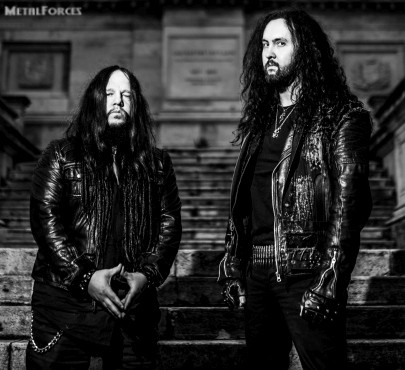 Joey Jordison and Frédéric Leclercq |
“Yeah though, I do listen to other genres of music, so maybe that chord progression comes from… Fuck knows… 80s music, and that chord progression is going to come from jazz fusion. For example, on the new EP, there’s the song ‘Monarch Of Death’; the two solos that I play on this are very much influenced by Allan Holdsworth. Allan Holdsworth isn’t really death or black metal, but that’s jazz fusion. I’m trying to bring those elements as well though, in the songs. I think you can hear a lot of Ministry in the chorus, but that’s what I had in mind. There are external influences, a lot of them. Everything combined is leading towards death and black metal, if that makes sense.”
The death metal bands that the Sinsaenum mainman enjoys largely derive from the inaugural wave. “I like the stuff that I discovered when I was young,” he explains. “I don’t really pay attention to what’s new now. Right now, I’m actually sporting a beautiful Morbid Angel T-shirt. That’s my favourite band. I love Morbid Angel, Pestilence, Carcass, Entombed, Dismember, Death, Cannibal Corpse, Atheist, Loudblast as a matter of fact, Grave… I’m trying to think… Napalm Death, Benediction. All of the bands from that era, when death metal came out – from ’89 to ’93, ’94. A lot of the bands that came out around that time were very good.”
Debut full-length studio album Echoes Of The Tortured arrived in July 2016 via earMUSIC. “We had very good reviews,” Frédéric enthuses. “All of them were pretty positive. The only complaint that we had was that Attila wasn’t too present on the album. He was always there, but maybe not as loud as Sean. Just because of the style, we recorded more of Sean’s abilities – it was more death than black. On the EP, it’s really 50/50, but on the album, it was more death metal. I guess Sean’s voice was more required, so people were complaining about this, and they were complaining about the fact that we had interludes. For them, it was killing the pace of the album. To me, it was completely the opposite. You can’t please everyone, but I really wanted to have a modern Testimony Of The Ancients (September 1991), from Pestilence. I think it’s nice to have those little breaks leading to another song, to create that sort of tension rather than go like ‘Song, song, song’ – which we will do on the next album, because it’s fine too. For this though, this is why I wanted to tell a story that didn’t exist.
“I wanted to take people on sort of a musical journey. To do that, it was nice to have those one-minute interludes in-between each song, so that it never stops. You sort of float, like on the cover. There are spirits floating. Each echo was like a song; everything is floating. You have a song, and then you float onto the next one. That’s what I was trying to do, but I’m super-happy with the results. I’m very proud of this album – we all are – and again, I’m happy that most people really got it. That’s great. It would have been awesome to go on tour for it, but it was difficult with everybody’s busy schedules. Obviously right now, I’m on tour with DragonForce, Attila is with Mayhem, Joey is doing Vimic. There’s Loudblast as well, who are busy. It’s a bit difficult.”
Interim follow-up Ashes, a six-track EP affair, emerged in November 2017. Inaugurating proceedings happens to be the title track. “This is more straightforward than most of the songs we’ve got on the first album,” the bassist describes. “Also, there’s the production of Francis Caste, because he took care of the mix and the master. It’s really in-your-face, and a little dirtier than Jens Bogren. I mean, I’m really happy with the work we did with Jens – Jens is an amazing producer – but I wanted something a little dirtier perhaps, and even more organic. Jens was already doing a lot of organic sounding productions, so with Francis, we’ve reached that step. I think it just starts straight in your face; there’s less intricate riffs, just a few. I think that song is really defines very well where Sinsaenum is in 2017; it’s straight in your face and more straightforward, but still with melodies and soloing. I think that’s a good example of what we’re doing, and what the next album is going to sound like.”
‘Ashes’’ lyrical content was penned by Frédéric, Attila, and Sean. “It’s not a particular story – it doesn’t really tell a story,” Frédéric views. “We like to think in terms of images, and the world burning and turning into ashes. That’s what inspired the music. I had the title ‘Ashes’ already. I liked the idea of that, of when it burns and nothing’s left but ashes. I guess that’s how I envisioned the song; I just talked about it with them, and that’s what it ended up being.”
A music video was filmed to highlight the cut. “We contacted the artist through Stéphane,” the keyboardist divulges. “We gave him cart blanche; we just told him ‘Okay, here’s the song. Tell us how you feel, and just give us an idea of a scenario,’ and he just came back with this. He’s very talented. I really liked the black and white, because it goes well with… I mean, I love black and white stuff in general, so that was the only thing I said. I said ‘Can we have it in black and white, please?’ He was like ‘That’s the story of someone who goes progressively into the depths of madness.’ He’s followed by someone, something, but it’s his own mind. I like the fact that it’s his own interpretation of the lyrics. That’s better than me telling him ‘Okay, this song is about this,’ or ‘I want this to be blah blah.’ It was more like an artistic approach of letting him, with the music and the lyrics, do what he felt. We’re very pleased with the result.”
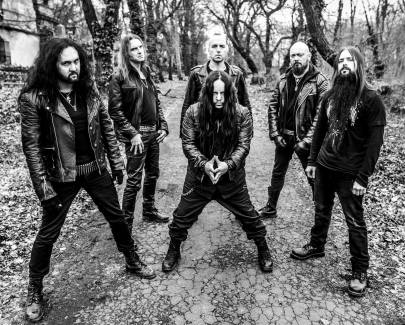 Sinsaenum (l-r): Frédéric Leclercq, Heimoth, Joey Jordison (front), Attila Csihar (back), Stéphane Buriez and Sean Zatorsky |
 |
![]() ‘Monarch Of Death’ positions itself at track two. “That’s another song I took from the vault of my old songs – it’s from back when I wanted to do a black metal side project,” Frédéric recalls. “I just liked the vibe of that one, and I thought that it would be interesting to turn it into a Sinsaenum song. Attila is more prominent on that one, because it has more of a black metal vibe, and yet Sean appears in the middle. Like I said, it’s a combination of the strong black metal elements, but also a lot of death metal here and there, and solos that are just fusion-influenced. Maybe on paper it sounds weird, but I think when you listen to the song, it just makes sense. It flows nicely from one place to another without being too much ‘What the fuck is going on?’ I think its style blends into another without too many problems, and the lyrics are pretty Satanic, obviously.”
‘Monarch Of Death’ positions itself at track two. “That’s another song I took from the vault of my old songs – it’s from back when I wanted to do a black metal side project,” Frédéric recalls. “I just liked the vibe of that one, and I thought that it would be interesting to turn it into a Sinsaenum song. Attila is more prominent on that one, because it has more of a black metal vibe, and yet Sean appears in the middle. Like I said, it’s a combination of the strong black metal elements, but also a lot of death metal here and there, and solos that are just fusion-influenced. Maybe on paper it sounds weird, but I think when you listen to the song, it just makes sense. It flows nicely from one place to another without being too much ‘What the fuck is going on?’ I think its style blends into another without too many problems, and the lyrics are pretty Satanic, obviously.”
The Satanic lyrical flavour relates to the chorus. “The chorus just felt like an invocation, which actually… I did a little research, and I was trying to find a Satanic ritual,” the axeman discloses. “Like when you repeat a sentence, when you’re in a sort of trance – like an invocation of the Fallen Angel coming forth. I like that. It is clichéd, but all these songs are clichéd. Everything has been done before. I just find the imagery of Satan interesting. I don’t believe; no-one is Satanic and believes in Satan per se, but the concept is interesting. I think it worked with the song, and the chords, and the progression, and the way it felt. It just felt right to talk about that, and not talk about… I don’t know… Making a sandwich, or something.”
‘2099 (Heretics)’ is more grandiose, perhaps. “Musically, that’s maybe a bit more complex, a bit more epic,” Frédéric observes. “It has touches of Cradle Of Filth towards the end, or at least I think so. It has like a strong, also kind of Gorgoroth vibe to it, but still with death metal elements and the sound that makes it Sinsaenum – with the voice of Sean and those solos and what not. Again though, that one has a very strong black metal vibe to it. As for the lyrics, I don’t want to explain too much because I just did an interview before, and they were asking me what ‘2099’ means. I’m just saying that it’s based on something that happened in 1099. This is also pretty Satanic, but just with a twist. I prefer to remain vague, which is also why we didn’t put the lyrics on the EP.
“People can try to interpret it and figure out what we’re screaming about, but if they don’t, then it doesn’t really matter. I’d rather leave it like that than people going ‘Actually, ‘2099’ is about this,’ because then you lose a bit of the mystery of it and because the song sounds a little bit mysterious by itself. That’s why Stéphane and I chose the title ‘2099 (Heretics)’. Yeah though, in terms of music, this one is dark and epic and with different tempo changes, but again I think it flows very nicely. To me, the ending reminds me of a little bit of Cradle Of Filth around the Cruelty And The Beast kind of vibe (May 1998), like subtle synths in the background and melodic guitars. Other than that, it’s a very aggressive song, and I’m very happy with the way it turned out.”
1099 was the period of the Crusades. ‘Degeneration’ was previously a Japan-only bonus track, meanwhile. “The Crusades was correct,” the four-stringer confirms. “‘Degeneration’ was from sessions for the first album. We had to make a choice, because we couldn’t put all of the songs on the album and all of them were good. That one had more of a thrash element to it, like a kind of Sodom vibe to it; more straight to the point, and more thrashy perhaps than the others. So, I decided to leave it as a bonus for Japan because it just sounded like a bonus. I liked all of the songs that we did for Echoes Of The Tortured, so it was a real torture. No pun intended, but to actually have to go ‘Oh, that song’s not gonna be on the main album,’ it was.
“That’s why when we did this EP, I was thinking about that. I was thinking in threes – three new songs and three old songs – which is why you have the two Japanese bonus tracks and ‘Dead Souls’ with a new mix, and Japan has three bonuses so they don’t feel left out, like ‘They took all the fucking bonuses.’ No, no. Now, you have three extra bonuses. Yeah, ‘Degeneration’ has more of a thrash vibe to it.”
Sean authored the lyrical fare on ‘Degeneration’. “Right now, they’re not in my head…,” Frédéric confesses. “Give me a second, so I can remember… I guess it’s anger towards society. We actually talked about it not so long ago, because we want to start working on lyrics for the new album. I sent him some words here and there, and just told him ‘I’m sorry, man. You’re gonna think I’m sounding like some paranoid, terroristic, demented old man, but I hate everyone. It fucking sucks. I hate society.’ He goes ‘Yeah, man (laughs). That’s the same way I feel. I’m so fucking angry.’ So, I guess it’s not hard for us to just release our anger in music. ‘Degeneration’ is about that; just a hatred of the world nowadays.”
‘King Of The Desperate Lands’ rounds out the pair of tracks previously exclusive to Japan. “‘King Of The Desperate Lands’ was the oldest song that I wrote for Sinsaenum, but back then it was not called Sinsaenum,” the guitarist informs. “It was around the time when I wanted to be in a death / black metal band. I did a demo tape that I wanted to give to two bands, but I never had the balls to give it to them (laughs). I just had that tape of songs that I made. I remember going to a festival and Immortal were playing, and Deicide as well. I had this big plan of ‘Oh, I’m going to give it to blah blah’ but just ended up giving it to a guy in the crowd, like ‘I’m doing this. You take it.’ My plan was to give it to them, and try to apply for a job. I think that song, I wrote in ’98. The Japanese, I gave them the original version from ’98. It sounds pretty horrible because it was done on my eight-track, and I’m singing in this horrible, strong French accent. It’s funny, though.
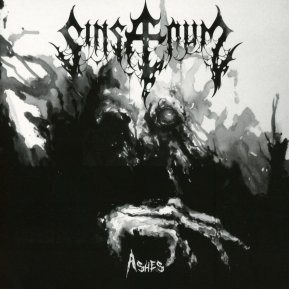 |
“Now, obviously we re-worked the song for the album. I like it. In a way, it sounds a bit like ‘Ashes’; it has the same sort of vibe, with touches of synth. Again, it was very difficult to not put it on the album, but I guess the reason why we put it as a Japanese bonus was probably because the ending fades out just like ‘Echoes Of The Tortured’. I think that’s the reason why we agreed, and said ‘Fuck it. Let’s put it as a bonus instead.’ I really like that song – we all really like that song. It was one that Joey discovered at the beginning, when we had the demos of the song. So yeah, it was a bit hard to not put it on the album. Again though, I had to make a choice. As for the lyrics, it’s about the war. Stéphane took care of the lyrics on that after spending some days with his grandfather, who was in the First World War. It’s based on that.”
Concluding the EP Ashes is a remix of the song ‘Dead Souls’, remixed by Frédéric Duquesne. “As I said, I wanted to have three songs, so we had those two bonuses,” Frédéric Leclercq tells. “One song that we particularly liked on the first album but didn’t do much with was ‘Dead Souls’. We know Frédéric Duquesne, who plays in Mass Hysteria. He produces a lot of bands and has a really nice studio and a really nice sound, so we just wanted to try it out with him. At first in my head, I wanted to re-do ‘Death Is The Beginning’, but Stéphane got it wrong and gave him ‘Dead Souls’ instead. I was like ‘Fuck no… Oh wait… That’s actually not a bad idea.’ I know Max (Vaccaro), the boss from the label, really liked that song as well. It was to sort of give that song a second chance, in a way. We have a new mix, which I believe is a bit more powerful. We redid the solos as well, to make it a bit more interesting. Yeah though, that song, if you compare the two, both of them have their own qualities. I’m pretty happy with that new version.”
Cover artwork duties were handled by Maxime Taccardi. “Maxime Taccardi is a French guy who is famous for painting with his own blood,” the Sinsaenum mainman imparts. “The cover is obviously in black and white though, so it doesn’t have blood. He does very dark, fucked up things. I actually discovered him with Drakhian, the ex-guitar player from Loudblast, because I was on tour with Loudblast – Stéphane is obviously from Loudblast. We were just sitting down in the dressing room, and he said ‘Hey guys. I’ve actually found that guy, and I think he would be great for Sinsaenum. He paints with his own blood, blah blah.’ We went through all of the stuff that he’s done, and I was just like ‘Fucking hell. That’s so cool.’
“He had one particular painting that I really liked; that’s the one that I wanted to use for the EP, but it was already taken. He said ‘I’ve already used it for my personal side project, but if you want me to make something remotely in the same vein, I can.’ I was like ‘Yeah, please do.’ He sent me two versions and I liked them both, so both of them are on the album. One is on the cover, and the other one is on the CD. I think it fits perfectly with the sound of the album, which is more raw, dark, and the fact that it’s black and white, and the skull is sort of hiding its face. Everything works fine together.”
A second full-length jaunt is in the midst of being created. “I’ve already written most of the songs for the next album, and we plan on releasing it – in my head, making those big plans – in September 2018 it should be, and then we go on tour,” Frédéric outlines. “That’s the plan for now, and the style is pretty much like the song ‘Ashes’, like I said. I guess that’s where we are at the moment, but then again, everything can change in-between the next few months before we go into the studio.”
Outside of Sinsaenum, the bassist remains active as a member of DragonForce. “With DragonForce, the plan is to survive the end of the tour,” he quips. “There’s like three or four shows left, and I’m really fucking tired (laughs). The plan is to survive and come back home safely from Russia in a couple of days, and then we’re going to take some well-deserved time off. I don’t know. We didn’t do any European festivals last year, so I’d imagine that we will do that, and then work on the new album as well.”
Ashes was released on November 10th, 2017 via earMUSIC.
Related Posts via Categories
- SCOTTISH SICKNESS – A Report On The Scottish Death Metal Scene, Featuring BRAINBATH, PUTRID FATE And RANCID CADAVER (October 2022) | Features / Interviews @ Metal Forces
- LARVAE – Join The Hardcore Cult! (June 2022) | Features / Interviews @ Metal Forces Magazine
- TRENCH FOOT – Sacrificing Morals For Gory Obscenities (June 2022) | Features / Interviews @ Metal Forces Magazine
- L.A. GUNS – Trigger Happy (March 2019) | Features / Interviews @ Metal Forces Magazine
- CANCER – Crimes So Evil (November 2018) | Features / Interviews @ Metal Forces Magazine
- U.D.O. – The Tank Drives On (August 2018) | Features / Interviews @ Metal Forces Magazine
- SIEGE OF POWER – Bleeding For The Cause (August 2018) | Features / Interviews @ Metal Forces Magazine
- MOONSPELL – A Taste Of Live Eternity (August 2018) | Features / Interviews @ Metal Forces Magazine
- MONSTROSITY – Dark Matter Invocation (August 2018) | Features / Interviews @ Metal Forces Magazine
- SATAN – Five Magicians (August 2018) | Features / Interviews @ Metal Forces Magazine
|
|
